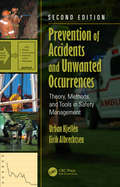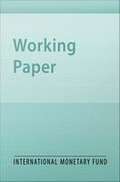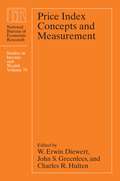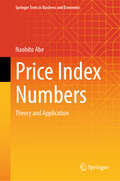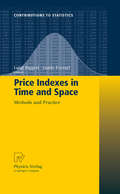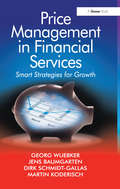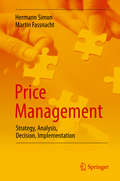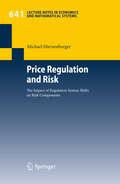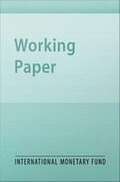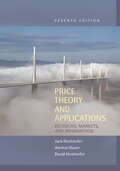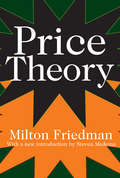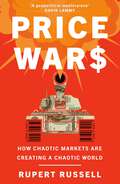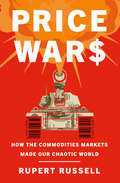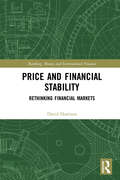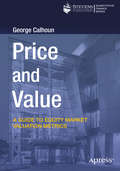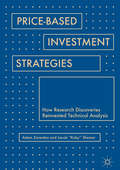- Table View
- List View
Prevention of Accidents Through Experience Feedback
by Urban KjellenProviding a practical introduction to the basic theories and principals of accident prevention through diagnosis and feedback control, this book presents the various methods and tools of safety, health, and environment (SHE) practice where experience feedback is employed. These include methods of accident and near accident reporting and investigati
Prevention of Accidents and Unwanted Occurrences: Theory, Methods, and Tools in Safety Management, Second Edition
by Urban Kjellen Eirik AlbrechtsenThis new edition comes after about 15 years of development in the field of safety science and practice. The book addresses the question of how to improve risk assessments, investigations, and organizational learning inside companies in order to prevent unwanted occurrences. The book helps the reader in analyzing the subject from different scientific perspectives to demonstrate how they contribute to an overall understanding. It also gives a comprehensive overview of different methods and tools for use in safety practice and helps the reader in analyzing their scope, merits, and shortcomings. The book raises a number of critical issues to be addressed in the improvement process.
Prevention of Air Pollution: Selected Paper in 2024 9th International Conference on Advances in Energy and Environment Research (Environmental Science and Engineering)
by Qiang Wang Ahmad Hosseini-BandegharaeiThis book offers readers with analysis of the main causes and purification technology of air pollution.Air, as the primary element on which human life depends, directly impacts human living and health. However, a 2022 report from the World Health Organization indicated that "the air nearly the entire global population (99%) breathes exceeds WHO air quality limits, threatening their health". Currently, the main approaches to air pollution involve source control and the treatment of air pollutants.Analyzing the causes of air pollution is an effective method for controlling pollution from its source and preventing its spread. It is also an efficient and rapid way to identify harmful gas components and then apply targeted treatment.Currently, big data model analysis and sensor perception technology are widely used analytical techniques. Combined with chemical transport models, they can simulate and predict pollutants, achieving better causal analysis and forecasting.Additionally, air pollution purification is an important component of prevention of air pollution.Currently, the most important research direction is how to purify air pollution without causing secondary environmental contamination, in addition to physical and chemical means.This book provides engineers and researchers in the field of air pollution prevention with research findings related to this area. It aims to share specific and valuable knowledge and content to improve prevention of air pollution efforts.
Price Analysis of China's Carbon Emissions
by Wenju WangThis book explores the determination of China’s carbon emission targets, especially with regard to the allocation of responsibility of China’s import and export carbon emissions, and carbon emission quota allocations across different time periods, industries, and regions.Research outside of China tends to focus on methods and approaches of carbon emission reduction policies and the impact of their implementation. Instead, within China, the focus has been on discussion of the necessity and conditions for China's development of a low-carbon economy as well as its introduction as a concept in the light of overseas comparisons. This book utilizes game theory, mechanism design, input-output theory, econometric theory and other methods to scrutinize China's carbon emissions and carbon emissions targets across different periods, industries, and regions. The result is a detailed theoretical and empirical investigation of carbon emission issues in the Chinese context. The book will be essential reading for students and scholars of economics, especially those with a focus on Chinese economic development and policymakers in the low-carbon economy sphere.
Price Discrimination
by Anirudh DhebarThis note, which is introductory in nature, provides a classification scheme for some of the more common examples of price discrimination. For each case that is discussed, the note characterizes the appropriate market segments, the alternative product "versions," and the differences in the firm's economics from one version to another.
Price Dynamics in the Eastern Caribbean
by Yan Sun Rupa DuttaguptaA report from the International Monetary Fund.
Price Imputation and Other Techniques for Dealing with Missing Observations, Seasonality and Quality Change in Price Indices
by Fenella Maitland-Smith Paul A ArmknechtA report from the International Monetary Fund.
Price Index Concepts and Measurement
by W. Erwin Diewert John Greenlees Charles R. HultenAlthough inflation is much feared for its negative effects on the economy, how to measure it is a matter of considerable debate that has important implications for interest rates, monetary supply, and investment and spending decisions. Underlying many of these issues is the concept of the Cost-of-Living Index (COLI) and its controversial role as the methodological foundation for the Consumer Price Index (CPI). Price Index Concepts and Measurements brings together leading experts to address the many questions involved in conceptualizing and measuring inflation. They evaluate the accuracy of COLI, a Cost-of-Goods Index, and a variety of other methodological frameworks as the bases for consumer price construction.
Price Index Numbers: Theory and Application (Springer Texts in Business and Economics)
by Naohito AbeThis textbook offers a comprehensive yet concise introduction to the theory behind price indices, covering the basics, historical background, necessary mathematical foundations, and contemporary cutting-edge theories. For those looking to study price indices, the most commonly used resources have traditionally been the comprehensive but voluminous CPI Manual, which is aimed at statistical practitioners, or Balk (2008), which, while covering theory concisely, requires advanced mathematical skills. This book is distinctive in that it (1) places emphasis on the relationship between price indices and economic theory, (2) presents cutting-edge methods and topics such as multilateral indices using scanner data and price measurement using Engel curves, and (3) provides explanations of essential mathematical techniques like functional equations, thus enabling self-study from the fundamentals to the forefront of modern index number theory.
Price Indexes in Time and Space: Methods and Practice
by Luigi Biggeri Guido FerrariThis book deals with the currently most relevant topics in price index numbers theory and practice. The problem of the harmonization of Consumer Price Indexes (CPIs) and the time-space integration of baskets is analyzed at the EU-zone level, with methodological and practical proposals on how to proceed for an overall treatment of the matter. Another issue is comparisons between Purchasing Power Parities (PPPs) and CPIs. Likewise, the construction of sub-indexes for households, economic and social groups is investigated, in order to obtain specific inflation measurement instruments. The book provides evidence from the most updated databases. Among the other issues treated in this book are spatial comparisons of price levels through PPPs and the international comparisons of macroeconomic aggregates, a re-consideration of index numbers theory, the measurement of production in non-market services, deflation problems, and price indexes in financial markets.
Price Liberalization in Russia
by Vincent Koen Steven PhillipsPrices in the Russian Federation have been decontrolled in several steps since early 1991, after decades of near fixity. This paper documents and analyzes the behavior of prices, income, consumption, and savings before and after the January 1992 price liberalization, with emphasis on developments during 1992, and with focus on households more than on enterprises. Comparisons are made with recent experience in Central and Eastern Europe, along with consideration of evidence on shortages and income distribution.
Price Management in Financial Services: Smart Strategies for Growth
by Georg Wuebker Jens Baumgarten Martin KoderischThe financial services industry is undergoing a period of dramatic change. Deregulation has created an ultra-competitive marketplace and recent challenges like the worldwide subprime crisis, SEPA and Basel II have only intensified the need for financial services providers to shift their focus to customer centric Smart Profit Growthâ„¢ strategies. Price Management in Financial Services shows how to utilize the modern techniques of value-based pricing to design professional pricing processes that go beyond the industry's current norm of purely risk and cost based pricing. The authors provide insight into strategic pricing concepts such as market segmentation, product bundling, multi-channel pricing and non-linear pricing and give an overview of advanced price optimization methods. The book serves as a step-by-step guide to long term profitable growth through professional pricing by familiarizing the reader with the concepts of price-response function management and price elasticity of demand. The book also includes a number of implementation strategies to incorporate Power Pricing into financial services institutions and includes a large number of Simon-Kucher & Partners' international case studies that illustrate the enormous profit potential that lies in professional pricing.
Price Management: Strategy, Analysis, Decision, Implementation
by Hermann Simon Martin FassnachtIn this book, the world’s foremost experts on pricing integrate theoretical rigor and practical application to present a comprehensive resource that covers all areas of the field. This volume brings together quantitative and qualitative approaches and highlights the most current innovations in theory and practice. Going beyond the traditional constraints of “price theory” and “price policy,” the authors coined the term “price management” to represent a holistic approach to pricing strategy and tactical implementation. They remind us that the Ancient Romans used one word, pretium, to mean both price and value. This is the fundamental philosophy that drives successful price management where producer and customer meet. Featuring dozens of examples and case studies drawn from their extensive research, consulting, and teaching around the world, Simon and Fassnacht cover all aspects of pricing following the price management process with its four phases: strategy, analysis, decision, and implementation. Thereby, the authors take into account the nuances across industry sectors, including consumer goods, industrial products, services, and trade/distribution. In particular, they address the implications of technological advancements, such as the Internet and new measurement and sensor technologies that have led to a wealth of price management innovations, such as flat rates, freemium, pay-per-use, or pay-what-you-want. They also address the emergence of new price metrics, Big Data applications, two-sided price systems, negative prices, and the sharing economy, as well as emerging payment systems such as bitcoin. The result is a “bible” for leaders who recognize that price is not only a means to drive profit in the short term, but a tool to generate sustained growth in shareholder value over the longer term, and a primer for researchers, instructors, and students alike.Praise for Price Management“This book is truly state of the art and the most comprehensive work in price management.” - Prof. Philip Kotler, Kellogg School of Management, Northwestern University “This very important book builds an outstanding bridge between science and practice.“ - Kasper Rorsted, CEO, Adidas “This book provides practical guidelines on value creation, communication and management, which is an imperative for businesses to survive in the coming era of uncertainty.” - Dr. Chang-Gyu Hwang, Chairman and CEO, KT Corporation (Korea Telecom)
Price Regulation and Risk
by Michael HierzenbergerNatural monopolies are not subject to the market-based principle of competition. Consequently, it is necessary to control companies in such monopoly positions with regard to their pricing. In the future, it will become more and more important to consider a possible change in the regulation regime when the future-oriented costs of equity - both in terms of price regulation and for conducting capital market-oriented business valuations - are to be determined. Based on the principal-agent problem, the book explains this topic. The effect of a change in the regulation regime is presented in the form of two studies: an international secondary analysis of the effects on cost of equity based on event studies of the Anglo-Saxon area and a primary analysis based on the Austrian regulation policy for electricity and gas supply systems. The two studies arrive at similar results: The change from a rate-of-return regulation to incentive regulation systems leads to a significant increase in systematic risk.
Price Setting in a Model with Production Chains: Evidence from Sectoral Data
by Maral ShamlooA report from the International Monetary Fund.
Price Theory and Applications
by Jack Hirshleifer, Amihai Glazer and David HirshleiferThis bestselling textbook stresses the inherent usefulness of economic theory, and is based on the belief that it can only be studied in connection with applications. It shows how economics can help us understand market behaviour, guide personal and financial decisions, and explain behaviour in areas such as politics, crime, and the family. It has been written for the standard intermediate microeconomics course. brings the theory to life; many fully worked numerical exercises throughout; presents an in-depth analysis of product quality; covers modern material, such as game theory, markets with imperfect information, and finance theory; includes a broader discussion of the coase theorem, including a diagrammatic exposition.
Price Theory: A Provisional Text (1962)
by Milton FriedmanEconomics is sometimes divided into two parts: positive economics and normative economics. The former deals with how the economic problem is solved, while the latter deals with how the economic problem should be solved. The effects of price or rent control on the distribution of income are problems of positive economics. The desirability of these effects on income distribution is a problem of normative economics.Within economics, the major division is between monetary theory and price theory. Monetary theory deals with the level of prices in general, with cyclical and other fluctuations in total output, total employment, and the like. Price theory deals with the allocation of resources among different uses, the price of one item relative to another.Prices do three kinds of things. They transmit information, they provide an incentive to users of resources to be guided by this information, and they provide an incentive to owners of resources to follow this information. Milton Friedman's classic book provides the theoretical underpinning for and understanding of prices.Economics is not concerned solely with economic problems. It is a social science, and is therefore concerned primarily with those economic problems whose solutions involve the cooperation and interaction of different individuals. It is concerned with problems involving a single individual only insofar as the individual's behavior has implications for or effects upon other individuals. Price Theory is concerned not with economic problems in the abstract, but with how a particular society solves its economic problems.
Price Wars: How Chaotic Markets Are Creating a Chaotic World
by Rupert RussellFor Rupert Russell, the shock of the Trump-Brexit victories was only the latest in a decade full of them: the unstoppable war in Syria, huge migrant flows into Europe, beheadings in Iraq, children caged at the US border. In Price Wars he sets out on an improbable journey to investigate what caused the wave of chaos that consumed the world in the 2010s.Armed with a notebook, flak jacket and pink socks, Russell travels to modern apocalypses across five continents, embedding with separatist soldiers in the trenches of Eastern Ukraine, gangs of street kids battling over garbage in Caracas, the UN bomb disposal squad in Iraq and cattle raiders in Northern Kenya. He traces the origins of these conflicts back to dramatic and mysterious swings in the prices of essential commodities. He meets with commodity speculators who describe the inner workings of these volatile markets, explaining how food prices can spike even in years of abundant harvests, causing bread riots and revolutions. Oil prices can surge on rumours, enriching and emboldening dictators and terrorists alike. These price shocks, and many others across the decade, triggered local disasters that became global catastrophes. It is chaotic prices, Russell learned, fuelled by banks and hedge funds in New York and London, that have toppled regimes and fractured the West.Price Wars is a page-turning chronicle of discovery and a ground-breaking expose of the power of price to devastate the world.
Price Wars: How the Commodities Markets Made Our Chaotic World
by Rupert RussellA fascinating, groundbreaking exposé of how commodity traders in New York and London have destabilized societies all over the world, leaving the most vulnerable at the mercy of hunger, chaos, and war.For Rupert Russell, the Brexit vote was only the latest shock in a decade full of them: the unstoppable war in Syria, huge migrant flows into Europe, beheadings in Iraq, children placed in cages on the U.S. border. In Price Wars, he sets out on a worldwide journey to investigate what caused the wave of chaos that consumed the world in the 2010s.Russell travels to Tunisia, Iraq, Venezuela, Ukraine, East Africa, and Central America and discovers that unrest in all these places was triggered by dramatic and mysterious swings in the price of essential commodities. Deregulation of the commodities markets means that food prices can shoot up even in years of abundant harvests, causing hunger and protest. Oil prices and real-estate values can surge even when supplies are normal, enriching and emboldening dictators. It is this instability--fueled by banks and hedge funds in faraway New York and London--that has toppled regimes and unsettled the West. Price Wars is a fascinating, original, and groundbreaking exposé of the power of the commodities markets to disrupt the world.
Price and Financial Stability: Rethinking Financial Markets (Banking, Money and International Finance)
by David HarrisonWhy are financial prices so much more crisis-prone and unstable than real economy prices? Because they are doing different things. Unlike real economy prices, rooted in the real goods and services produced and exchanged, financial prices attempt to value future income flows from financial and capital assets. These valuations fluctuate erratically because expectations of the future fluctuate – and large liquid financial markets can amplify, rather than correct, these effects. The book builds on the insights of economists Frank Knight and John Maynard Keynes, that uncertainty of the future is essential to understand the processes of economic production and capital investment, and adds to this Karl Popper's general explanation of how expectations of an uncertain future are formed and tested through a trial and error process. Rather than relying on fluctuating financial prices to provide a guide to an uncertain future, it suggests a better approach would be to adopt the methods common to other branches of science, and create testable (falsifiable) theories allowing reasonable predictions to be made. In finance, the elements of one such theory could be based on the concept of forecasting yield from capital assets, which is a measurable phenomenon tending towards aggregate and long-term stability, and where there is a plentiful supply of historic data. By methods like this, financial economics could become a branch of science like any other. To buttress this approach, the widely accepted public policy objective of promoting real economy price stability could be widened to include financial price stability.
Price and Prize of Leadership: Being a More Effective Leader
by Gareth Jones Rob GoffeeLeadership is complicated, and the secrets of great leadership resist simple recipes. The fact is that leadership is a risky occupation. This chapter revisits some important strategies for achieving authentic leadership, assuring leaders that whatever the price of taking risks, the prize is worth it.
Price and Value: A Guide to Equity Market Valuation Metrics
by George CalhounUnderstand how to use equity market metrics such as the price/earnings ratio (and other multiples) to value public and private enterprises. This essential book gives you the tools you need to identify and qualify investments and assess business strategy and performance. Author George Calhoun, Founding Director of the Quantitative Finance Program at Stevens Institute of Technology, shows you how to use metrics to appraise mergers, acquisitions, and spin-offs. You will be able to shed light on financial market conditions, benchmark fair value assessments, and check and calibrate complex cash flow models. Market multiples share a peculiar construction: they are based on an explicit apples-to-oranges comparison of market prices with accounting fundamentals, combining data derived from two very different sources and methodologies. This creates ambiguities in interpretation that can complicate the application of these metrics for the many purposes. Multiples are thus easy to construct, but they can be difficult to interpret. The meanings of certain multiples have evolved over time, and new-and-improved versions have been introduced. The field is becoming more complex and the question of which metrics perform best can be a source of controversy.What You Will Learn Know the definitions, interpretations, and applications of all major market ratios, including: price/earnings (trailing and forward), cyclically adjusted price/earnings, cash-adjusted price/earnings, EV/EBITDA, price/sales, dividend yield, and many moreExamine the factors that drive the values of ratios from firm level (such as earnings growth, leverage, and governance) to market level (such as inflation, tax and fiscal policy, monetary policy, and international characteristics)Apply metrics in: investment analysis, index construction, factor models, sum-of-the-parts analysis of corporate structures, and detection of asset bubblesWho This Book Is For Professionals at all levels working in the finance industry, especially in fields related to investment management, trading, and investment banking who are involved with valuation and assessing and advising on corporate transactions and interpreting market trends, and university students in finance-related programs at the undergraduate and graduate levels
Price-Based Investment Strategies: How Research Discoveries Reinvented Technical Analysis
by Adam Zaremba Jacob Koby" ShemerThis compelling book examines the price-based revolution in investing, showing how research over recent decades has reinvented technical analysis. The authors discuss the major groups of price-based strategies, considering their theoretical motivation, individual and combined implementation, and back-tested results when applied to investment across country stock markets. Containing a comprehensive sample of performance data, taken from 24 major developed markets around the world and ranging over the last 25 years, the authors construct practical portfolios and display their performance—ensuring the book is not only academically rigorous, but practically applicable too. This is a highly useful volume that will be of relevance to researchers and students working in the field of price-based investing, as well as individual investors, fund pickers, market analysts, fund managers, pension fund consultants, hedge fund portfolio managers, endowment chief investment officers, futures traders, and family office investors.
Price-Fixing Vignettes
by Guhan Subramanian Michelle KalkaThis case escribes the antitrust prosecutions in the United States and abroad of the international bulk vitamins cartel. Both the civil and criminal fines were historically high, and it was the first time the United States prosecuted foreign nationals for U.S. criminal antitrust charges. It also details allegations of price-fixing by NASDAQ securities traders, which began when an academic paper accused NASDAQ market makers of avoiding quotes with odd-numbered increments. The remaining vignette provides an account of the price-fixing scandal involving Christie's and Sotheby's fine-art auction houses.
Price-Quantity Determination
by Anirudh DhebarExamines the important economic considerations affecting a firm's price-quantity decision for a product. Begins with a discussion of the appropriate decision criterion. Next, it motivates the concept of a demand curve for a product and defines demand elasticity. Marginal analysis is used to establish the following necessary condition for optimal price and quantity: marginal revenue must equal marginal cost. Price-quantity determination in the presence of a resource constraint and competition is also discussed.

